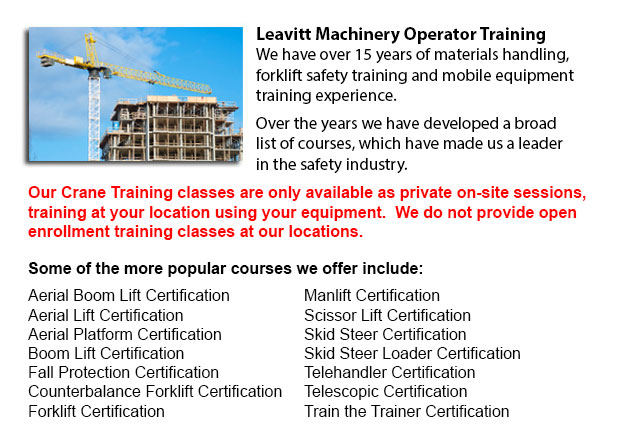
Overhead Crane Operator Training Burlington - Our overhead crane operator training program is intended to teach staff the basics of overhead crane/sling operation and pre-shift checks. Courses are taught by our professional trainers and consultants. Well-trained workers are more efficient and productive, that saves on costs connected with property damage, merchandise damage, and accidents because of the use of improper operating measures. Our overhead crane certification is customized for workers who have literacy barriers, reducing certification time by 50 percent.
The overhead crane has been made to be used performing repetitive lifting activities. This type of crane can be used in numerous capacities. They may be used for specialized hoisting jobs like for example installing or removing major plant machinery.
Worker and operators should employ safe rigging practices to be able to safely operate an overhead crane. This would require both practice and knowledge because the load needs to be properly rigged to guarantee its stability when lifted. Before starting a hoisting job, it should be determined that the crane is right for the job, with right capacity, travel and lift. The crane needs to be subjected to a thorough physical and visual check before use. The capacity of all machinery, including the rope, slings and hardware, should never go beyond load weight capacities.
The rigger has to know the correct sling for every lift and inspect slings and other rigging hardware prior to utilizing. Clear signals need to be used in communications with the crane operator. A signaler has to be designated for the role and signals have to be agreed upon. The crane operator must follow directions from the designated person only. If a wired or remote controller is being used, the operator must be trained in all its functions.
In order to guarantee the safety of employees, a warning must be issued and the path of the load should be cleared of all obstacles before the lift starts. People must not be allowed to walk under the lift loads. The crane hoist should be centered over the load prior to hoisting to prevent swinging. The safety catch must be closed immediately after sliding the sling entirely onto the lifting hook. Sling legs which are not utilized must be secured so they do not drag. Never leave loose materials on a load being hoisted. Watch that hands and fingers are clear when slack is taken out of a sling. Step clear of the danger zone before the lift is made.
-
Order Picker Training Burlington
Order Picker Training Burlington - Order picker's enables warehouse employees to lift pallets using forks. Also called a stock picker, this particular electrically-powered equipment is similar to a forklift except that an order picker is likewise uti... More -
Crane Certification Burlington
Crane Certification Burlington - The Crane Certification training program includes content recommended by industry regarding the efficient and safe operation of cranes. Trainees would learn the following: how to identify cranes and their component pa... More -
Overhead Crane Training Burlington
Overhead Crane Training Burlington - The overhead crane is a piece of equipment which can lift and move huge, heavy objects which can't be handled by hands. Typically, overhead cranes are fixed in place. These equipment are capable of moving huge vol... More -
Aerial Lift / Boom Lift / Man Lift / Scissor Lift Training in Burlington
Lift tables or scissor lifts could elevate both people and goods vertically. They are normally used in construction, commercial and industrial environments. Commonly, the use of a scissor lift is to lift and lower supplies from one floor of a job loc... More -
Telehandler Operator Training Burlington
Telehandler Operator Training Burlington - Telescopic Handler forklifts or telehandler forklifts are usually found on construction places and their popularity continues to rise. The versatility of telehandler forklifts ensures that they are a valuabl... More -
Forklift Training Classes Burlington
Forklift Training Classes Burlington - Forklift are heavy pieces of industrial machines that are made use of in transporting and the handling of merchandise and materials. They are often known as Lift trucks and are found in all sorts of businesses.... More -
Boom Lift Training Burlington
Boom Lift Training Burlington - Aerial platforms or also known as elevated work platforms are devices that allow workers to perform tasks and duties at elevated heights that would not be otherwise accessible. There are a variety of aerial lifts avail... More -
Bucket Truck Training Burlington
Bucket Truck Training Burlington - The Vehicle-Mounted Aerial Work Platform or also called bucket truck training program is intended to decrease the risk of incident and personal injury while working in close proximity or with bucket trucks by effici... More

Forklift Training Burlington
TOLL FREE: 1-888-254-6157
Burlington, Ontario
forklifttrainingburlington.com
Email Us
About Us


